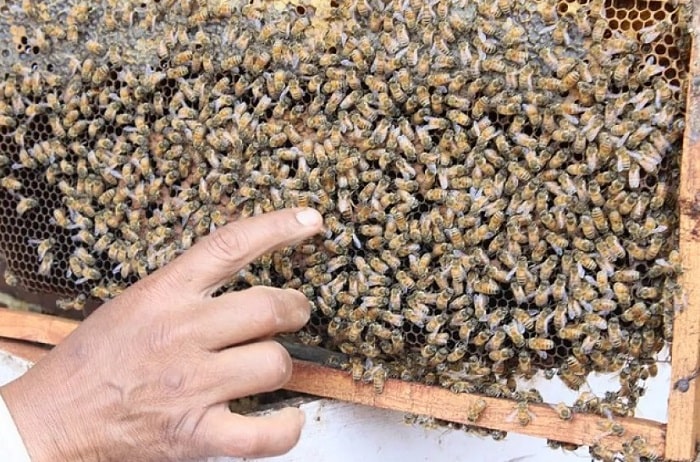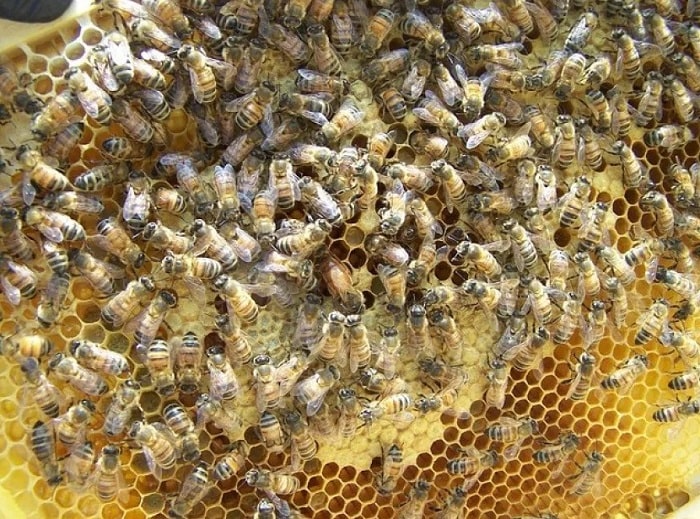One of the most frustrating things for a beginner beekeeper is locating the queen bee. Having a good queen in residence is critical to the colony’s success. And, certainly, the beekeeper must occasionally locate the queen in order to execute various hive management activities. So, how to find the queen bee?
Finding the queen bee in a hive
It’s not just new beekeepers who have trouble finding a queen bee. Even old beekeepers struggle from time to time. It can be difficult to find a single bee in a colony of 30-60 thousand bees. One really special bee that looks a little different from the others – 59,999.
It can be difficult to learn how to locate the queen bee in a large colony. It is possible that more than one attempt will be required. We sometimes need to close the hive and return another day. Once you have mastered the knack of spotting a queen, dealing with hive management concerns becomes much easier. Your confidence is bolstered, and sometimes just believing that you can do it is enough to help you succeed.
Fortunately, we do not always have to find our queen. We can sometimes seek for signals of a laying queen. Fresh eggs (just one per cell) and new patterns of young bee brood are signs of a laying queen in the hive – if that looks okay, you may not need to discover her.

What does a queen bee look like?
You can not improve your chances of locating the queen bee if you do not know what she looks like! In some ways, she resembles a bee; both the queen bee and the workers are female. Furthermore, some employees can appear rather huge. When the queen begins to lay eggs, her abdomen expands, making it easier to locate her. She is frequently found near the brood nest because that is where she performs her duties.
The queen bee is larger, but more specifically, she is longer. Her lengthy abdomen extends out beyond the tip of her wings, giving her the appearance of having short wings. Her back, too, is different from that of most workers. She has a shiny, black hairless back, while workers tend to have fuzzy backs. Her legs are long and usually light, while worker bees tend to have dark legs.
Tips for identifying a queen bee
Some beekeeping abilities necessitate hands-on practice, which only time can provide. Finding a queen bee quickly in a frame full of bees is one of those skills that develops. Some races have lighter-colored queen bees that are easier to find, but do not count on them. However, here are some pointers to help you discover your queen.
-
Mark your queens
When purchasing honey bees, pay a premium for a marked queen or mark her yourself. Queens with markings are easy to find. Beekeepers employ a variety of methods, the most important of which is to ensure that you only mark her “thorax” and do not get paint on her eyes, wings, or other body parts. You can, of course, choose whatever queen marking color you want – or the International queen bee marking colors.
-
Check the brood nest first
A honey bee queen’s job is to lay eggs. Egg laying often begins in the hive’s center and spreads outward. Locate the brood nest, which is the location within a honey bee colony that contains eggs, larvae, and capped brood. Look for frames that contain eggs or larvae (milk brood). This is the youngest section of the brood nest and is most likely where the queen will be. However, the queen could be anywhere, so exercise caution when moving any hive pieces. She appears when I least expect her.

>>> Read more: TOP 10 Best Beekeeping Suits Reviews & Buying Guide
-
Develop a hive inspection procedure
Every beekeeper has a unique method of inspecting hives. To interrupt the colony’s alarm pheromones, employ a bee smoker that emits cold, white smoke. Lightly smoke the hive entrance. It is critical to learn how to use your bee smoker correctly — do not over smoke. After a few minutes, remove the telescopic top. Pry the inner cover off with a hive tool and set it aside.
The initial objective is to investigate the deep brood box (the one on the bottom), which is most likely to contain the queen. Your brood nest, on the other hand, could be further up in the hive stack. If you can not find her in the bottom box, move on to the next box up the stack, and so on.
-
Remove a couple of frames to make room
It is now time to use the hook hive tool. Remove the frame in the #2 position with the hook hive tool or any other tool you have. The second frame from the left is this one. The queen is less likely to be present if a frame towards the outside is removed.
Take a look at the frame you just took out (including the first one); the queen may be everywhere. If you do not find the queen after inspecting the second frame, return it to the hive. You have some extra space because one of the frames on the frame perch has been removed. Lift each frame carefully and place it over the hive to inspect it. If the queen falls off the frame, she will land in the hive rather than on the ground.
-
Watch for the slow waggle walk of a queen
A laying honey bee queen walks in a certain way. Her huge abdomen waggles across the honeycomb frame.
Can you practice locating the queen bee?
Many beekeepers struggle to discover their queens and give up on improving this talent. Nevertheless, with a little work, you can enhance your ability to find the queen!
The queen bee differs from the other bees in appearance. Her body is long, but her wings are relatively short. She is the only bee in the hive whose wings do not extend all the way to the bottom of her abdomen. She also has long legs and a bald back. If these characteristics are insufficient, some beekeepers can identify her by a change in pattern. Her attendants follow her as she goes fast around the comb, and when she stops, they create a circle around her, forming a flower-like design.
Conclusion
Practice makes perfect, but as a beginner beekeeper, your chances of finding queens are likely to be restricted. You might only have one or two colonies, and you do not want to stress them out by opening them too frequently. At most, you will be able to search your hive for a queen a couple of times per month.
>>> Don’t forget to see: How High Should A Beehive Be Off The Ground?
